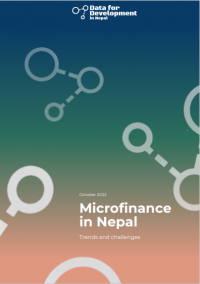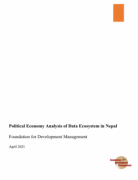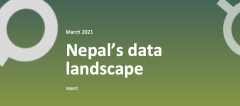
Census Observation – Nepal Census 2021
December 28, 2022
Microfinance in Nepal: Trends and Challenges
January 13, 2023Microfinance in Nepal: What’s gone wrong and how it can be turned around.
[DI and WEData, in partnership with The Asia Foundation, recently completed a study on microfinance in Nepal. Its findings and recommendations have been published. This blog summarises some of those findings.]
For decades microfinance has been lauded as a significant development tool. To the extent that Grameen Bank, perhaps the most famous microfinance institution in the world, along with its founder Muhammad Yunus, won the Nobel Peace Prize in 2006 for their work creating “economic and social development from below”. Nowhere else has microfinance been talked up more than in South Asia, where it is a significant part of the region's development landscape. This is no different in Nepal, where the general consensus among government officials, industry stakeholders and academics is that microfinance has a pivotal role to play in reducing poverty and empowering women. For example, the country's latest Monetary Policy (2022/23) has a whole section dedicated to it, and the most recent budget (2022/23) outlined a Rs 500 billion fund – around US$3.8 billion – to extend credit to farmers.
Rapid progress in the Microfinance sector now has turned into an empowerment movement among women across the country. Microfinance is necessary to overcome exploitation, create confidence for economic self-reliance of the rural poor, particularly among women.”
Guvaju and Sherpa (2020)[1]
Recently, though, microfinance has been making the news in Nepal for all the wrong reasons. On 13 October Kantipur – one of the country’s most-read newspapers – published the front-page headline ‘Microfinance is more ferocious than loan sharks’. It reported details of a protest held in Kathmandu (which followed smaller demonstrations in other places) against what disgruntled people from all seven provinces believe is an industry which has lost its way, by charging exorbitant interest on loans and offering pitiful returns on savings. The ex-governor of the Nepal Rastra Bank conceded that “MFIs [microfinance institutions] have become profit orientated and the Bank has not been able to effectively regulate them”.
The prioritisation of profit by microfinance institutions underlies the discontent. Previously the supply side of microfinance was made up of a mixture of civil society organisations, non-governmental organisations (NGOs) and private banks. However, this changed in 2007 when the Nepal Rastra Bank specified that all institutions delivering microfinance must become private banks with shareholders. Through the 2010s the government then encouraged more private microfinance institutions to open to increase competition. The logic behind this thinking was to reap the rewards of increased efficiency, which policymakers had hoped would translate into decreased costs being passed onto more consumers. What transpired is quite the opposite. The market became saturated culminating with 90 separate microfinance institutions operating at the same time in 2019. And since investors stand to make a greater return from microfinance than other financial services they piled in and became powerful stakeholders.
The government has made moves to reduce the number of microfinance institutions operating and to put a stop to what it labels “unhealthy competition”. And by encouraging mergers and acquisitions the number of institutions has fallen to 61. But it has not made similar efforts to soften profit-seeking tendencies. Significantly, the maximum rate of interest that can be charged – now 15%, a markedly higher cap than for other types of lending – has not been lowered and will not be for the foreseeable future. Moreover, there have been multiple reports of interest rates exceeding 18% being regularly charged, something which the government has failed to quell. On top of this, the system to check people’s credit history is malfunctioning, meaning people can take out multiple loans from different microfinance institutions. This undermines the Nepal Rastra Bank policy which is supposed to limit the amount one person can borrow to Rs 0.7 million, to prevent people accruing unsustainable debt. On 20 December 2022, the Nepal Microfinance Bankers Association reached a 12 point agreement with representatives of those that have been protesting, aiming to overcome some of the challenges facing the industry. Some key issues, such as spiralling debt and multiple borrowing, do feature in the agreement, but lack specific and actionable solutions. The government has not taken part in the negotiations that led to the agreement, nor does it endorse the outcome, which undermines its credibility.
Against this backdrop, Development Initiatives and Women’s Entrepreneur Data studied the trends and challenges that microfinance in Nepal faces, and have released the paper, Microfinance in Nepal: trends, challenges and solutions, to summarise our findings. This provides a snapshot of what’s happening in the sector based on analysis of the latest available data. It confirms that microfinance institutions are growing in terms of branches, customers, credit lent and profits. A trend which held firm through the Covid-19 pandemic. The paper also documents findings from interviews with key actors, centred around three central problems:
Microfinance has lost sight of its original social objective.
The government has failed to regulate the sector effectively.
There is a dearth of quality data and information for policymakers and other stakeholders to use to make evidence-informed decisions.
We also provide recommendations on solutions to the challenges identified, including:
The government should be engaging directly with the groups protesting about MFI practices, rather than delegating it to a voluntary association with no real power to deliver changes in the sector.
The government should accompany policies that aim to spread microfinance services to hard-to-reach areas with policies and investments that aim to strengthen local economies.
The government needs to rigorously enforce the 15% cap on interest rates, and seriously consider how it can be lowered.
Government, universities, donors and NGOs should fund research into the current protest movement, documenting and evidencing the stories of women.
The Credit Information Bureau and Nepal Rastra Bank should work together to effectively tackle the issue of multiple borrowing.
This study was carried out under the Data for Development in Nepal Programme, which is led by The Asia Foundation and funded by UK aid from the Foreign, Commonwealth and Development Office (FCDO). Development Initiatives and Women’s Entrepreneur Data extend our gratitude to both these organisations.
This blog was authored by Sam Wozniak, Information Systems Analyst at Development initiatives.
The views presented in this blog are the author’s, and do not necessarily reflect those held by The Asia Foundation or the FCDO.




